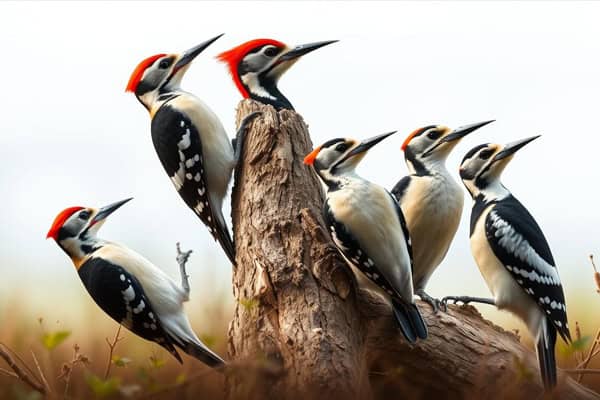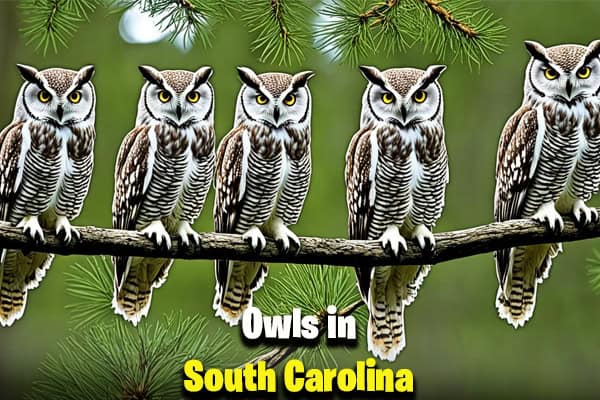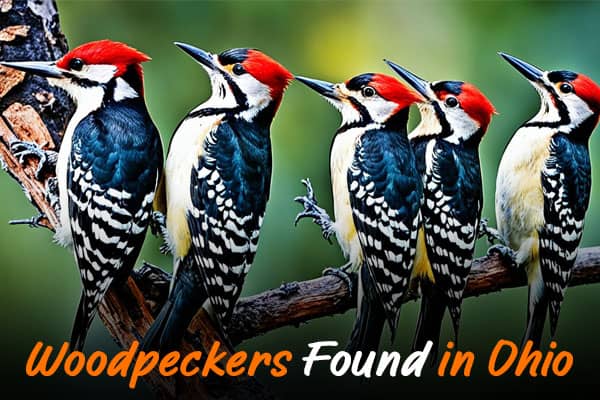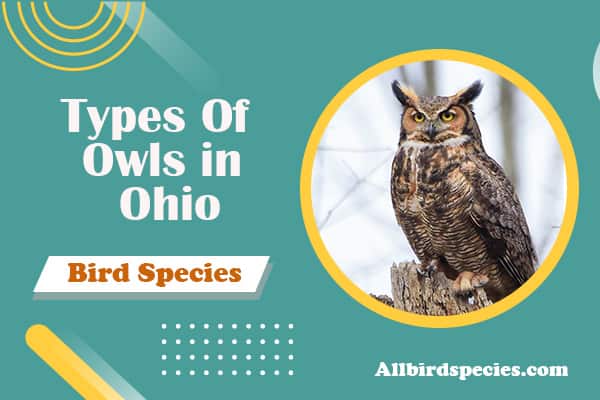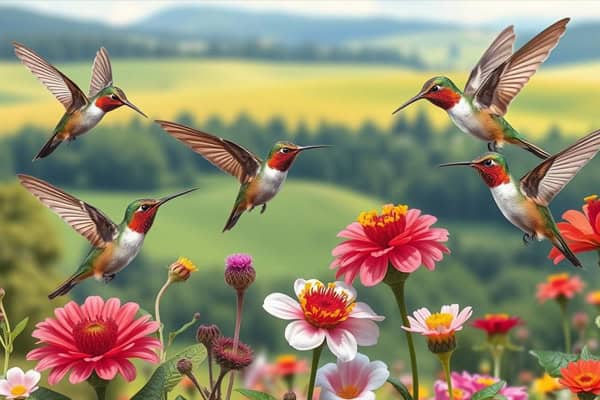Woodpeckers in Maryland – 7 Common Species & ID Guide
Did you know Maryland has 20 different types of woodpeckers? Seven of these species call Maryland’s forests home. This fact shows how vital these birds are to our local ecosystems. We’ll explore Maryland’s woodpecker habitats and learn about their unique traits and roles.
This guide introduces you to seven common woodpecker species found in Maryland. You’ll see the Red-Headed Woodpecker’s bright colors and hear the Northern Flicker’s unique calls. Each species will help improve your skills in identifying and appreciating woodpeckers in Maryland.
Common Woodpeckers Found In Maryland
- Red-Headed Woodpecker
- Red-Bellied Woodpecker
- Pileated Woodpecker
- Downy Woodpecker
- Hairy Woodpecker
- Yellow-Bellied Sapsucker
- Northern Flicker
1. Red-Headed Woodpecker
- Scientific name: Melanerpes erythrocephalus
- Life span: 8 – 10 years
- Size: 19 to 25 cm
- Weight: 56 to 97 g
- Wingspan: 35 to 43 cm
The Red-Headed Woodpecker is a standout among Maryland birds. It’s known for its bright red head, which looks great against its black body and white underparts. It’s about 19 to 25 cm big, making it easy to spot for bird watchers.

Physical Appearance
Identifying the Red-Headed Woodpecker is easy thanks to its colors. Its red head is very noticeable, and the rest of its body is black and shiny. The white underparts and big white wing patches make it stand out in flight.
Diet and Feeding Habits
The Red-Headed Woodpecker eats insects, fruits, and nuts. It has unique ways of finding food in trees. By foraging upside down, it gets insects from tree bark. This helps it survive and keeps the ecosystem balanced.
2. Red-Bellied Woodpecker
- Scientific name: Melanerpes carolinus
- Life span: 10-12 years
- Size: 22 to 26 cm
- Weight: 56 to 91 g
- Wingspan: 35 to 43 cm
We’re diving into the world of the Red-Bellied Woodpecker. We’ll look at its unique traits and nesting habits. These features help us spot it in the wild.

Distinctive Features
The Red-Bellied Woodpecker stands out with its bright look. It’s about 22 to 26 centimeters big. Its bright red cap is a clear sign. It contrasts with its light underparts and detailed back pattern.
The wings and back have black and white bars. These marks help us tell it apart from others. Knowing these traits is key to spotting it in different places.
Nesting Behavior
The way Red-Bellied Woodpeckers build their nests is quite interesting. They choose dead trees to make their homes. Both parents work together on the nest, showing their teamwork.
This teamwork is important for their young. It shows how they fit into the ecosystem.
| Feature | Description |
|---|---|
| Size | 22-26 cm |
| Cap Color | Crimson |
| Back Pattern | Black and white barring |
| Nesting Location | Decaying trees |
| Nesting Participation | Both partners participate |
3. Pileated Woodpecker
- Scientific name: Dryocopus pileatus
- Life span: 6-10 years
- Size: 16-19 inches
- Weight: 10-12 oz
- Wingspan: 26-30 inches
The Pileated Woodpecker is a standout in Maryland’s woodpecker species. It’s known for its large size and unique look. This bird catches the eye with its appearance and special forest homes. It’s a true treasure in our woods.

Size and Plumage
This woodpecker is quite big, measuring 16-19 inches long. It has a black body with white stripes on its face and neck. The bright red crest on its head makes it even more eye-catching. Spotting this bird is easy with these distinct traits.
Habitat Preferences
Pileated Woodpeckers live in big forests with old trees and dead wood. These places are perfect for them because they hunt insects in decaying wood. They also make homes for other birds by digging nesting holes. Knowing where they live helps us value their role in our forests.
| Characteristic | Description |
|---|---|
| Size | 16-19 inches |
| Plumage | Black with white stripes and red crest |
| Preferred Habitats | Old-growth forests, decaying wood areas |
| Diet | Primarily wood-boring insects, some fruits |
| Ecological Role | Creates nesting cavities for other species |
Woodpeckers in other Regions:
| Woodpeckers in Iowa |
| Woodpeckers in California |
| Woodpeckers in Wisconsin |
| Woodpeckers in Missouri |
| Woodpeckers in Montana |
4. Downy Woodpecker
- Scientific name: Picoides pubescens
- Life span: 2-5 years
- Size: 6-7 inches
- Weight: 1 oz
- Wingspan: 13 inches
Let’s explore the world of the Downy Woodpecker, a small bird that draws birdwatchers and nature lovers. It’s small but stands out and is crucial to our ecosystem. Knowing how to spot the Downy Woodpecker can make birdwatching more exciting, especially when focusing on small woodpeckers.

Size and Appearance
These Downy Woodpeckers in Maryland are about 6 to 7 inches long, making it a smaller woodpecker. It has black and white checkered feathers, with a black crown, white back, and white belly. These markings help us spot them easily against tree bark and leaves.
These birds can be seen in woods and city parks, showing off their unique behavior and flexibility. They mainly eat insects and tree sap. This shows their key role in controlling pests and making their homes richer.
| Feature | Description |
|---|---|
| Size | 6-7 inches in length |
| Plumage | Black and white checkered pattern |
| Habitat | Woodlands, urban parks |
| Diet | Insects, tree sap |
Learning about the Downy Woodpecker helps us appreciate these amazing birds more. They add beauty and life to our surroundings.
5. Hairy Woodpecker
- Scientific name: Picoides villosus
- Life span: 5-10 years
- Size: 7-10 inches
- Weight: 1.5 oz
- Wingspan: 16-20 inches
The Hairy Woodpecker is a bird that lives in our forests. It looks a lot like the Downy Woodpecker but has its own special traits. Let’s learn about what makes it unique and what it likes to eat.

Key Identifiers
It’s easy to tell the Hairy Woodpecker apart from the Downy by looking for certain signs.
- Size: The Hairy Woodpecker is bigger, about 9 to 10 inches long.
- Bill Length: Its bill is longer, almost as long as its head.
- Plumage: It has black and white feathers, but the white on its back and face is more visible.
- Call: It makes a sharp sound that helps us identify it.
Dietary Preferences
The Hairy Woodpecker eats insects and larvae from dead trees. This helps the forest ecosystem. They use their strong beaks to dig into bark to find beetles and ants. They eat on tree trunks and in branches, making sure they get enough food.
This diet is important for their survival and helps keep insects in check in their homes.
Related Video:
6. Northern Flicker
- Scientific name: Colaptes auratus
- Life span: 5-8 years
- Size: 8-10 inches
- Weight: 2.5 oz
- Wingspan: 14-16 inches
The Northern Flicker is a standout among Maryland’s woodpeckers with its unique looks and behaviors. It’s fun for both new and experienced birdwatchers to spot these birds. Their special colors, how they forage, and how they adapt make us appreciate them more.

Unique Features
Northern Flickers have a brownish color with black spots. This makes them easy to tell apart from other woodpeckers. They love to forage on the ground, digging for ants and beetles, which are key to their diet.
These birds migrate to different places in Maryland, making them adaptable. You can find them in open woods, parks, and even in suburban areas. Learning about Northern Flickers helps us understand their importance in nature.
| Characteristic | Description |
|---|---|
| Coloration | Brownish with black spots and a white rump |
| Diet | Mainly ants and beetles foraged from the ground |
| Habitat | Open woodlands, parks, and suburban areas in Maryland |
| Behavior | Ground foragers, often seen pecking on the ground |
| Migration | Seasonal migratory patterns throughout North America |
7. Yellow-Bellied Sapsucker
- Scientific name: Sphyrapicus varius
- Life span: 5-8 years
- Size: 8-10 inches
- Weight: 2.5 oz
- Wingspan: 14-16 inches
The Yellow-Bellied Sapsucker is a bird that catches the eye in Maryland. It’s easy to spot because of its bright yellow belly and red throat. These features make it stand out from other woodpeckers. They live in places with lots of trees that have sap, like wooded areas.

This bird has a sharp bill and bright colors that help it find food. It drills into trees to get to the sap and insects inside. This way, it gets a lot of food. Watching them do this shows how they’ve adapted to their environment.
Knowing where to look for these birds makes birdwatching more fun. Look for them in dense forests with trees like maples and birches. Seeing them means the ecosystem is healthy and full of life. Learning about how to spot them and what they eat deepens our connection with nature.
| Characteristic | Description |
|---|---|
| Appearance | Distinct yellow belly, red throat, and black and white markings |
| Habitat Preference | Forested areas with sap-rich trees |
| Feeding Behavior | Drilling holes in trees to access sap and insects |
| Nesting Sites | Cavities in trees, often near feeding areas |
Where to spot for Woodpeckers in Maryland
In Maryland, woodpeckers can be found in various wooded areas, including:
- Patuxent Research Refuge (Laurel)
- Rock Creek Park (Chevy Chase)
- Gunpowder Falls State Park (Baltimore County)
- Seneca Creek State Park (Gaithersburg)
- Cunningham Falls State Park (Thurmont)
These locations offer dense forests and old trees, ideal habitats for spotting woodpeckers like the Pileated, Red-bellied, and Downy Woodpeckers.
Check Our Previous Articles:
Wrapping Up…
As we finish our look at Maryland’s common woodpeckers, we see each bird’s unique role in our ecosystem. From the eye-catching Red-Headed Woodpecker to the hardworking Downy Woodpecker, we learn about their special traits. These traits help keep our environment balanced.
Learning how to identify woodpeckers is great for birdwatchers and everyone else. It helps us understand these amazing birds better. By watching their actions and where they live, we learn more about nature. Woodpeckers are key to our ecosystem, helping with pest control and keeping forests healthy.

